ALESIS FUSION
ANALOG SYNTHESIS TUTORIAL
Now... because the process is just math, the sum and difference
frequencies are inevitably
harmonically unrelated (enharmonic) and thus
the ring modulator is very adept at making
discordant sounds.
However, worth bearing in mind is the fact that the ring modulator doesn’t just produce the
sum
and difference of the fundamental frequencies of
both inputs but also their harmonics. Thus,
feeding harmonically complex waveforms such as sawtooth or
square waves into the ring
modulator can produce some truly
discordant sounds to the point of being an unmanageable
cacophony! With that in mind, it is often
best to just use simple sine or triangle waves with the
ring modulator as you tend to have more control over the discordancy.
Used tastefully, the ring modulator can be used to create beautiful, sonorous bell and chime
sounds. In fact, there is some confusion about
the origins of the name ‘ring modulator’ - did it
come from the ring of diodes that was used on the
inputs of the original analog designs or the
fact that it produces enharmonic ringing bell sounds?!
The ring modulator can
also produce some spectacular early ‘sci-fi’ sounds reminiscent of the
50s and 60s
4
especially if the pitch of one
of the inputs changes during the course of a note.
As the pitch of one of the oscillators moves away from the other, you hear
a kind of metallic
‘squealing’ sound as the enharmonic sum and difference frequencies change over time.
But the ring modulator has other uses.
As an octave splitter for example. Think about it - feed a 440Hz
signal into both inputs and the
sum and difference is 880Hz (one octave up) and 0Hz (no signal).
The ring
modulator was (is) also famously used to create the voice of the Daleks from the
classic BBC science fiction series, Dr Who. One input is fed with
an audio oscillator generating
somewhere in the region of 30Hz
and the other is fed with a microphone with an actor
speaking the lines (typically “EXTERMINATE”!!). The result is a menacing, robotic vocal effect.
Similar
techniques can be used using a higher frequency oscillator to create a ‘tingling’ vocal
effect.
And of course, you’re not restricted to ring modulating vocals - try drums or guitar... whatever!
Fusion allows external
audio inputs to be ring modulated in this way - simply select EXT IN as
one of the oscillator’s ‘waveforms’ and presto!!!
Granted, the ring modulator is
perhaps not the first module to reach for to create ‘mainstream’
sounds for your next foray into the hit parade (although the band Japan skilfully employed
such sounds in their hit ‘Ghosts’) but it is capable of producing a veritable smörgåsbord
of weird
and wonderful sounds, especially if very early, pioneering electronica is your bag!
Fusion’s ring modulator
goes one step further than ‘traditional’ ring modulators - as well as
being able to
ring modulate oscillators 1&2, 2&3 and 1&3, it is actually possible to ring
modulate all three oscillators for some serious sonic mayhem!!!
4
The ring modulator has been around for many decades, actually
long before the synthesiser as
we know it and
as such, many of the sounds you can create with a ring modullator are highly
reminiscent of and synonymous with early electronic music from such pioneers as
Louis and
Bebe Barron who created the first ever all-electronic music
film score for the classic movie,
‘Forbidden Planet’, and
also the BBC’s Radiophonic Workshop who provided electronic
soundtracks and sound effects for many BBC TV and radio production during the 60s including
Dr Who.
Sound processors / modifiers
Page
17

